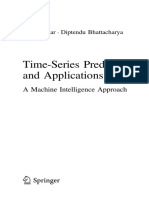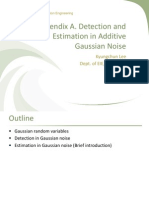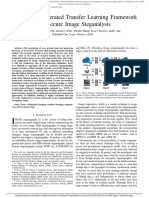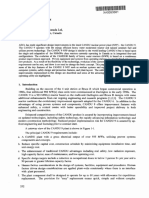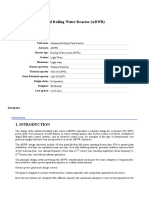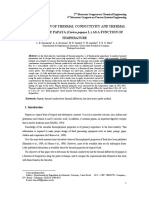Calculation of Pi Using The Monte Carlo Method
Uploaded by
DinkarCalculation of Pi Using The Monte Carlo Method
Uploaded by
DinkarCalculation of Pi Using the Monte Carlo Method
Calculation of Pi Using the Monte Carlo Method
by Eve Andersson
Home : Pi : One Calculation
The "Monte Carlo Method" is a method of solving problems Great Pi Day Gifts
using statistics. Given the probability, P, that an event will occur
in certain conditions, a computer can be used to generate those
conditions repeatedly. The number of times the event occurs
divided by the number of times the conditions are generated
should be approximately equal to P.
Run the Program View Source Code
How this program works:
If a circle of radius R is inscribed inside a square with side
length 2R, then the area of the circle will be pi*R^2 and the area
of the square will be (2R)^2. So the ratio of the area of the circle
to the area of the square will be pi/4.
This means that, if you pick N points at random inside the
square, approximately N*pi/4 of those points should fall inside
the circle.
This program picks points at random inside the square. It then
checks to see if the point is inside the circle (it knows it's inside
the circle if x^2 + y^2 < R^2, where x and y are the coordinates
of the point and R is the radius of the circle). The program
keeps track of how many points it's picked so far (N) and how
many of those points fell inside the circle (M).
Pi is then approximated as follows:
4*M
pi = ---
N
http://www.eveandersson.com/pi/monte-carlo-circle (1 of 5)8/5/2010 11:13:01 AM
Calculation of Pi Using the Monte Carlo Method
Although the Monte Carlo Method is often useful for solving
problems in physics and mathematics which cannot be solved
by analytical means, it is a rather slow method of calculating pi.
To calculate each significant digit there will have to be about 10
times as many trials as to calculate the preceding significant
digit.
Eve Andersson (eve@eveandersson.com)
Comments
Regarin the program
Hi eveander This is suresh here, doin my master in computers in ASU .As i'm a
graduate student, actully we had a topic on monte carlo (pi calculation ).when i
had gone through ur site i got stuff regardin this topic i'm interested in.I would like
to know the complete procedure and program code inorder to understand myself
clearly.I would be greatful to u and thanks for consider my above request.
Regards suresh
-- Suresh Babu Gajjela
Re: Regarin the program
I wonder if Suresh is looking for something like this.
#!/usr/bin/env python
import random
import math
count_inside = 0
for count in range(0, 10000):
d = math.hypot(random.random(), random.random())
if d < 1: count_inside += 1
count += 1
print 4.0 * count_inside / count
http://www.eveandersson.com/pi/monte-carlo-circle (2 of 5)8/5/2010 11:13:01 AM
Calculation of Pi Using the Monte Carlo Method
-- Larry Hosken
more digits
Wow, someone sent me some mail about the example. She wrote:
Thank You very much for it! But I would like to please Your help.
Could You tell please, what is nesessery to add to this programm for
to get Pi colculations in such view 3.******** (i mean in your
programm there are 4 numbers after point, but I need 8 numbers).
First, the unhelpful literal answer: To specify that you want to view 8 digits of the
number, you can use a formatted string. That is, instead of something like
print 4.0 * M / N
...you can say something like
print '%0.8f' % (4.0 * M / N)
However, when you try this, you will see it is not so useful: our result is an integer
divided by 10000. Thus, the last few digits are always zero. This leads to the
temptation to use a longer loop to get a more precise answer. But on my wimpy
computer, using a longer loop leads to a too-long run time. And raises questions
about how good my random number generator is. And when should I switch over
to arbitrary-precision numbers? Oh, now my head hurts.
-- Larry Hosken
Magic Numbers
Hi,
I would like to point to the fact that this particular method works especially well
when you make 14 pairs of random numbers. It works very well if you generate
452 numbers.
http://www.eveandersson.com/pi/monte-carlo-circle (3 of 5)8/5/2010 11:13:01 AM
Calculation of Pi Using the Monte Carlo Method
Using 14 pairs of random cooridante pairs you can get:3.1428571428571
Using 452 you can get as close to Pi as 3.141592920354
Probably you can work out why. ;)
I used Lua to generate these numbers, and the script is:
x=0
y=14
for i = 1, y
do
a=math.random()
b=math.random()
if (a^2+b^2<1 ) then x=x+1 end
end
print(4*x/y)
I think you can get a generally better approximation using something like this:
S=0
n=100
for i = 1, n
do
x=math.random()
y=(1-x^2)^0.5
S=S+y
http://www.eveandersson.com/pi/monte-carlo-circle (4 of 5)8/5/2010 11:13:01 AM
Calculation of Pi Using the Monte Carlo Method
end
T=4*S/n
print(T)
-- Szilard Bokros
Practical demonstration
The San Francisco Exploratorium - possibly the coolest kids museum on the
planet - has a large poker-chip-tossing machine on display for kids to calculate Pi.
On my last visit there a crowd of children - not even nerd children (sorry Eve, I'm
stereotyping here...) - were all standing around watching it.
-- Aidan Merritt
Old Method
This method, was known as "The method of the French Lieutenant" or "The
method of generating PI casting stones in a Pond".
MARIO
-- MARIO GIOIA
Add a comment
http://www.eveandersson.com/pi/monte-carlo-circle (5 of 5)8/5/2010 11:13:01 AM
You might also like
- A Quantitative Investigation On The Average Shadow Area of A CubeNo ratings yetA Quantitative Investigation On The Average Shadow Area of A Cube21 pages
- Amit Konar, Diptendu Bhattacharya-Time-Series Prediction and Applications. A Machine Intelligence Approach-Springer (2017)No ratings yetAmit Konar, Diptendu Bhattacharya-Time-Series Prediction and Applications. A Machine Intelligence Approach-Springer (2017)248 pages
- Learning From Data - A Short Course - Abu-Mostafa, Magdon-Ismail, Lin - AMLBook - Com - 2012 PDF33% (3)Learning From Data - A Short Course - Abu-Mostafa, Magdon-Ismail, Lin - AMLBook - Com - 2012 PDF215 pages
- An Introduction To Malliavin Calculus With Applications To EconomicsNo ratings yetAn Introduction To Malliavin Calculus With Applications To Economics83 pages
- NRC Generic Fundamentals Examination Question Bank - BWR100% (1)NRC Generic Fundamentals Examination Question Bank - BWR315 pages
- N. Metrópolis The Beginning of The Monte Carlo Method PDFNo ratings yetN. Metrópolis The Beginning of The Monte Carlo Method PDF6 pages
- Bayesian Stochastic Modelling in PythonNo ratings yetBayesian Stochastic Modelling in Python81 pages
- Applications of Artificial Neural Networks in Foundation Engineering100% (1)Applications of Artificial Neural Networks in Foundation Engineering25 pages
- App.A - Detection and Estimation in Additive Gaussian Noise PDFNo ratings yetApp.A - Detection and Estimation in Additive Gaussian Noise PDF55 pages
- 2020 - William L. Hamilton - Graph Representation Learning-Morgan & ClaypoolNo ratings yet2020 - William L. Hamilton - Graph Representation Learning-Morgan & Claypool161 pages
- Data Extraction & Exploration With SPARQL & The Talis PlatformNo ratings yetData Extraction & Exploration With SPARQL & The Talis Platform49 pages
- Generalized Linear Failure Rate DistributionNo ratings yetGeneralized Linear Failure Rate Distribution23 pages
- An Introduction To Bayesian Statistics and MCMC MethodsNo ratings yetAn Introduction To Bayesian Statistics and MCMC Methods69 pages
- Czekanowski Index-Based Similarity As Alternative Correlation Measure in N-Asset Portfolio AnalysisNo ratings yetCzekanowski Index-Based Similarity As Alternative Correlation Measure in N-Asset Portfolio Analysis1 page
- A Federated Transfer Learning Framework For Secure Image SteganalysisNo ratings yetA Federated Transfer Learning Framework For Secure Image Steganalysis11 pages
- Imbalanced Data: How To Handle Imbalanced Classification ProblemsNo ratings yetImbalanced Data: How To Handle Imbalanced Classification Problems17 pages
- Session 14 - Joint Probability Distributions (GbA) PDFNo ratings yetSession 14 - Joint Probability Distributions (GbA) PDF69 pages
- Gilbert Strang-The Algebra of Elimination (Expository Notes) (2011) PDFNo ratings yetGilbert Strang-The Algebra of Elimination (Expository Notes) (2011) PDF20 pages
- Towards Geometric Deep Learning I - On The Shoulders of GiantsNo ratings yetTowards Geometric Deep Learning I - On The Shoulders of Giants13 pages
- Equivalence and Reduction of Finite-State Machines100% (1)Equivalence and Reduction of Finite-State Machines24 pages
- Operation Research Problems Solving in Python: Prepared by Saurav BaruaNo ratings yetOperation Research Problems Solving in Python: Prepared by Saurav Barua15 pages
- Valipour, Mohammad - Long-Term Runoff Study Using SARIMA and ARIMA Models in The United States - 2No ratings yetValipour, Mohammad - Long-Term Runoff Study Using SARIMA and ARIMA Models in The United States - 27 pages
- Fuzzy Soft Set Theory and Its ApplicationsNo ratings yetFuzzy Soft Set Theory and Its Applications19 pages
- Roland Rudiger - Quantum Programming Languages:A SurveyNo ratings yetRoland Rudiger - Quantum Programming Languages:A Survey46 pages
- Regression Graphics: Ideas for Studying Regressions Through GraphicsFrom EverandRegression Graphics: Ideas for Studying Regressions Through GraphicsNo ratings yet
- 600/590 SLCB 564 Target 740+ Close Above 750 TGT 1040++: #Fairchemspeciality #Acendingtraingle #BreakoutNo ratings yet600/590 SLCB 564 Target 740+ Close Above 750 TGT 1040++: #Fairchemspeciality #Acendingtraingle #Breakout2 pages
- Solution of The Reactor Point Neutron Kinetic Equations With Temperaturem Feedback Control Using MATLAB-Simulink Toolbox - Mai IsmailNo ratings yetSolution of The Reactor Point Neutron Kinetic Equations With Temperaturem Feedback Control Using MATLAB-Simulink Toolbox - Mai Ismail4 pages
- State-of-the-Art Report On The Progress of Nuclear Fuel Cycle Chemistry100% (1)State-of-the-Art Report On The Progress of Nuclear Fuel Cycle Chemistry304 pages
- Design Considerations For Nuclear Reactor Gas Turbine Space Power SystemsNo ratings yetDesign Considerations For Nuclear Reactor Gas Turbine Space Power Systems5 pages
- Status Report 97 - Advanced Boiling Water Reactor (ABWR) : General Power Generation Design CriteriaNo ratings yetStatus Report 97 - Advanced Boiling Water Reactor (ABWR) : General Power Generation Design Criteria27 pages
- Central Intelligence Agency The Work of A Nation. The Center of Intelligence Search100% (2)Central Intelligence Agency The Work of A Nation. The Center of Intelligence Search8 pages
- Power Engineering Letters: Carlos Pérez-RojasNo ratings yetPower Engineering Letters: Carlos Pérez-Rojas3 pages
- Laying Out Simple Curve With An ObstructionNo ratings yetLaying Out Simple Curve With An Obstruction5 pages
- Trigonometry 1 (Angles and Applications)No ratings yetTrigonometry 1 (Angles and Applications)9 pages
- Solution Manual for College Physics 7th Edition by Wilson - Available With All Chapters For Instant Download100% (11)Solution Manual for College Physics 7th Edition by Wilson - Available With All Chapters For Instant Download51 pages
- The Concavity of The Great Pyramid:: A Design Feature? Did The Designer Know The Meter Unit?No ratings yetThe Concavity of The Great Pyramid:: A Design Feature? Did The Designer Know The Meter Unit?12 pages
- PRE CALCULUS Converting Degree Measure To Radian Measure and Vice VersaNo ratings yetPRE CALCULUS Converting Degree Measure To Radian Measure and Vice Versa7 pages
- HKDSE Mathematics in Action (3rd Edition) 5A - Chapter 01 Basic Properties of Circles - Full SolutionNo ratings yetHKDSE Mathematics in Action (3rd Edition) 5A - Chapter 01 Basic Properties of Circles - Full Solution57 pages
- Ncert Solutions Class 10 Maths Chapter 10 CirclesNo ratings yetNcert Solutions Class 10 Maths Chapter 10 Circles24 pages
- A Quantitative Investigation On The Average Shadow Area of A CubeA Quantitative Investigation On The Average Shadow Area of A Cube
- Amit Konar, Diptendu Bhattacharya-Time-Series Prediction and Applications. A Machine Intelligence Approach-Springer (2017)Amit Konar, Diptendu Bhattacharya-Time-Series Prediction and Applications. A Machine Intelligence Approach-Springer (2017)
- Learning From Data - A Short Course - Abu-Mostafa, Magdon-Ismail, Lin - AMLBook - Com - 2012 PDFLearning From Data - A Short Course - Abu-Mostafa, Magdon-Ismail, Lin - AMLBook - Com - 2012 PDF
- An Introduction To Malliavin Calculus With Applications To EconomicsAn Introduction To Malliavin Calculus With Applications To Economics
- NRC Generic Fundamentals Examination Question Bank - BWRNRC Generic Fundamentals Examination Question Bank - BWR
- N. Metrópolis The Beginning of The Monte Carlo Method PDFN. Metrópolis The Beginning of The Monte Carlo Method PDF
- Applications of Artificial Neural Networks in Foundation EngineeringApplications of Artificial Neural Networks in Foundation Engineering
- App.A - Detection and Estimation in Additive Gaussian Noise PDFApp.A - Detection and Estimation in Additive Gaussian Noise PDF
- 2020 - William L. Hamilton - Graph Representation Learning-Morgan & Claypool2020 - William L. Hamilton - Graph Representation Learning-Morgan & Claypool
- Data Extraction & Exploration With SPARQL & The Talis PlatformData Extraction & Exploration With SPARQL & The Talis Platform
- An Introduction To Bayesian Statistics and MCMC MethodsAn Introduction To Bayesian Statistics and MCMC Methods
- Czekanowski Index-Based Similarity As Alternative Correlation Measure in N-Asset Portfolio AnalysisCzekanowski Index-Based Similarity As Alternative Correlation Measure in N-Asset Portfolio Analysis
- A Federated Transfer Learning Framework For Secure Image SteganalysisA Federated Transfer Learning Framework For Secure Image Steganalysis
- Imbalanced Data: How To Handle Imbalanced Classification ProblemsImbalanced Data: How To Handle Imbalanced Classification Problems
- Session 14 - Joint Probability Distributions (GbA) PDFSession 14 - Joint Probability Distributions (GbA) PDF
- Gilbert Strang-The Algebra of Elimination (Expository Notes) (2011) PDFGilbert Strang-The Algebra of Elimination (Expository Notes) (2011) PDF
- Towards Geometric Deep Learning I - On The Shoulders of GiantsTowards Geometric Deep Learning I - On The Shoulders of Giants
- Equivalence and Reduction of Finite-State MachinesEquivalence and Reduction of Finite-State Machines
- Operation Research Problems Solving in Python: Prepared by Saurav BaruaOperation Research Problems Solving in Python: Prepared by Saurav Barua
- Valipour, Mohammad - Long-Term Runoff Study Using SARIMA and ARIMA Models in The United States - 2Valipour, Mohammad - Long-Term Runoff Study Using SARIMA and ARIMA Models in The United States - 2
- Roland Rudiger - Quantum Programming Languages:A SurveyRoland Rudiger - Quantum Programming Languages:A Survey
- An Introduction to Metric Spaces and Fixed Point TheoryFrom EverandAn Introduction to Metric Spaces and Fixed Point Theory
- Regression Graphics: Ideas for Studying Regressions Through GraphicsFrom EverandRegression Graphics: Ideas for Studying Regressions Through Graphics
- 600/590 SLCB 564 Target 740+ Close Above 750 TGT 1040++: #Fairchemspeciality #Acendingtraingle #Breakout600/590 SLCB 564 Target 740+ Close Above 750 TGT 1040++: #Fairchemspeciality #Acendingtraingle #Breakout
- Solution of The Reactor Point Neutron Kinetic Equations With Temperaturem Feedback Control Using MATLAB-Simulink Toolbox - Mai IsmailSolution of The Reactor Point Neutron Kinetic Equations With Temperaturem Feedback Control Using MATLAB-Simulink Toolbox - Mai Ismail
- State-of-the-Art Report On The Progress of Nuclear Fuel Cycle ChemistryState-of-the-Art Report On The Progress of Nuclear Fuel Cycle Chemistry
- Design Considerations For Nuclear Reactor Gas Turbine Space Power SystemsDesign Considerations For Nuclear Reactor Gas Turbine Space Power Systems
- Status Report 97 - Advanced Boiling Water Reactor (ABWR) : General Power Generation Design CriteriaStatus Report 97 - Advanced Boiling Water Reactor (ABWR) : General Power Generation Design Criteria
- Central Intelligence Agency The Work of A Nation. The Center of Intelligence SearchCentral Intelligence Agency The Work of A Nation. The Center of Intelligence Search
- Solution Manual for College Physics 7th Edition by Wilson - Available With All Chapters For Instant DownloadSolution Manual for College Physics 7th Edition by Wilson - Available With All Chapters For Instant Download
- The Concavity of The Great Pyramid:: A Design Feature? Did The Designer Know The Meter Unit?The Concavity of The Great Pyramid:: A Design Feature? Did The Designer Know The Meter Unit?
- PRE CALCULUS Converting Degree Measure To Radian Measure and Vice VersaPRE CALCULUS Converting Degree Measure To Radian Measure and Vice Versa
- HKDSE Mathematics in Action (3rd Edition) 5A - Chapter 01 Basic Properties of Circles - Full SolutionHKDSE Mathematics in Action (3rd Edition) 5A - Chapter 01 Basic Properties of Circles - Full Solution




